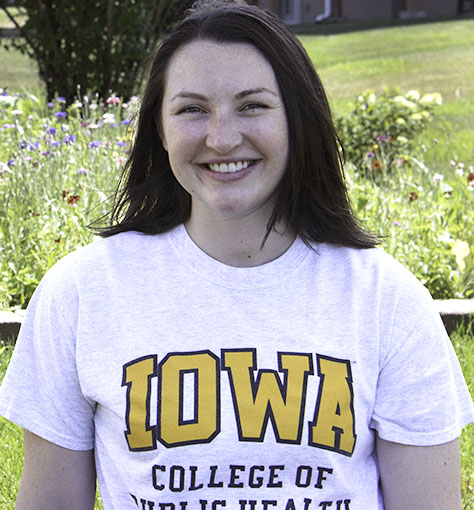Breadcrumb
Q&A with biostatistics student Caitlin Ward
Published on July 29, 2020
 Caitlin Ward, a doctoral student in the College of Public Health, is using her statistical skills to tackle important public health issues like COVID-19. Originally from Iowa City, Ward found her calling close to home in Iowa’s biostatistics program, where opportunities to engage in research and teaching and the chance to build relationships with faculty and other students has made an positive impact on her educational experience.
Caitlin Ward, a doctoral student in the College of Public Health, is using her statistical skills to tackle important public health issues like COVID-19. Originally from Iowa City, Ward found her calling close to home in Iowa’s biostatistics program, where opportunities to engage in research and teaching and the chance to build relationships with faculty and other students has made an positive impact on her educational experience.
Q: How did you become interested in biostatistics?
A: I didn’t know biostatistics existed until the end of my junior year of undergrad. I was a math major and was completing an actuarial internship. I really enjoyed the statistical modeling I did at my internship, but I was not excited about the subject matter. I started looking into other types of jobs that use statistics, and that’s when I stumbled across biostatistics. It was the perfect way to combine my love of math with practical applications in an area I was interested in. After that, I changed my major to statistics and began to seriously consider grad school for biostatistics.
Q: What drew you to the program at Iowa?
A: Being from Iowa City, I knew how prestigious University of Iowa Hospitals & Clinics is for medical research. I liked that the biostatistics program was in the College of Public Health, as some programs are just part of larger statistics departments. Another plus was the size of the department, as there are lots of opportunities to do different types of research, but also to form close relationships with faculty and students. And I love being close to my family!
Q: You’re part of a team that developed a tool that uses statistical modeling to better understanding the effects of non-pharmaceutical interventions, such as cloth masks and face shields, on COVID-19 in Iowa. What was your role in the project, and what skills or insights have you gained from that experience?
A: My role on the project was leading the graduate student team in the design and implementation of the web application. It was an exciting experience to utilize my biostatistical knowledge for such an important public health problem. With an emerging infectious disease, the situation is constantly changing and we had to continually adapt the tool to ensure it is as accurate and informative as possible. We also worked hard to create a user-friendly tool that displays interesting parameters and meaningful information in a concise way.
Q: You were honored with a 2019-2020 Outstanding Teaching Assistant Award. What do you enjoy most about teaching?
A: My favorite thing about teaching is getting to share my love of statistics with others. I’ve been teaching the Introduction to Biostatistics course for the past year, which is taken by non-majors with a lot of apprehension about learning statistics. I love engaging them with topics they are interested in and showing how biostatistics can help them answer questions they care about.
One of my favorite moments in the classroom was when we were first covering p-values and confidence intervals and a student said, “Oh! Now I understand what that means in journal articles!” It’s rewarding to have students see the value of the course material and connect it with research they’ve worked on or things they’ve learned in other classes.
Q: What are your career plans once you finish your degree?
A: I’m planning to graduate next May and I’m hoping to find a job in academia. Academia interests me because it offers me the chance to continue teaching and mentoring students while engaging in exciting research.
Q: Anything else you’d like to add?
A: I’m thankful for all of the supportive faculty and students in the biostatistics department. We have an extremely collaborative department, which I think is unique for graduate school and is a great atmosphere to be in.